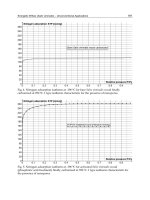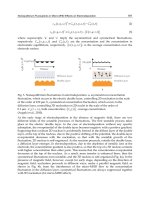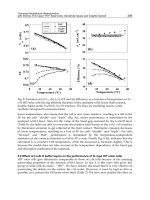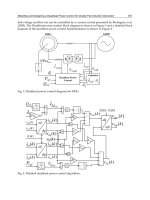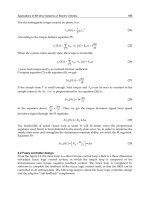Project Planning Control 4 E Part 11 doc
Bạn đang xem bản rút gọn của tài liệu. Xem và tải ngay bản đầy đủ của tài liệu tại đây (1.02 MB, 30 trang )
Fit coupling 1 33 10 12 100 10 12 100 10 12 100 10
Prefab. suction pipe 1 34 6 10 100 6 10 100 6 10 100 6
Prefab. discharge pipe 1 35 5 4 80 4 5 100 5 5 100 5
Erect suction pipe 1 36 7 ––– 8 100 7 8 100 7
Weld suction pipe 1 37 7 ––– 5 100 7 5 100 7
Support suction pipe 1 38 4 ––– 4 80 3 5 100 5
Erect discharge pipe 1 39 6 5 70 4 7 100 6 7 100 6
Weld discharge pipe 1 40 4 ––– 4 100 4 4 100 4
Support discharge pipe 1 41 4 ––– 2 50 2 3 100 4
Basic plate pump 2 50 4 3 100 4 3 100 4 3 100 4
Fit pump 2 51 14 14 100 14 14 100 14 14 100 14
Fit motor 2 52 14 12 100 14 12 100 14 12 100 14
Fit coupling 2 53 10 10 100 10 10 100 10 10 100 10
Prefab. suction pipe 2 54 6 10 100 6 10 100 6 10 100 6
Prefab. discharge pipe 2 55 5 6 100 5 6 100 5 6 100 5
Erect suction pipe 2 56 7 5 60 4 8 100 7 8 100 7
Weld suction pipe 2 57 7 ––– 5 100 7 5 100 7
Support suction pipe 2 58 4 ––– 2 40 2 4 100 4
Erect discharge pipe 2 59 6 6 70 4 8 100 6 8 100 6
Weld discharge pipe 2 60 4 ––– 5 100 4 5 100 4
Support discharge pipe 2 61 4 ––– 3 70 3 4 100 4
Align couplings 1 & 2 62 50 ––– ––– 16 40 20
Totals 530 324 56% 297 482 84% 448 525 94% 500
Project Planning and Control
280
7 Enter these durations in the network programme.
8 Carry out the network analysis, giving floats and the critical path (Table
28.9).
9 Draw up the SMAC analysis sheet (Table 28.10) listing activities, activity
(SMAC) numbers and durations.
10 Carry out SMAC analysis at weekly intervals. The basic calculations for
value hours, efficiency, etc. are shown in Table 28.11.
11 Draw a bar chart using the network as a basis for start and finish of
activities (Figure 28.13).
12 Place the number of men per week against the activities on the bar
chart.
Table 28.11 SMAC calculations
Day 5 Day 10 Day 15
Budget manhours 530 530 530
Actual manhours 324 482 525
Value manhours 297 448 500
Percentage complete
297 448 500
530 530 530
= 56% = 85% = 94%
Est. final man hours
324 482 525
0.56 0.85 0.94
= 579 = 567 = 559
Efficiency
297 448 500
324 482 525
= 92% = 93% = 95%
A = Actual manhours
B = Budget manhours
V = Value manhours
V = Value manhours = Percentage complete × B of activity
⌺% complete =
⌺V
⌺B
efficiency =
V
A
Est. final =
A
% complete
Activities shifted: 17, 21, 22, 35, 55, 19
Worked examples
13 Add up vertically per week and draw the labour histogram and S-curve.
14 Carry out a resource-smoothing exercize to ensure that labour demand
does not exceed supply for any particular trade. In any case, high peaks or
troughs are signs of inefficient working and should be avoided here (Fig
28.14). (Note: This smoothing operation only takes place with activities
which have float.)
15 Draw the project control curves using the weekly SMAC analysis results
to show graphically the relationship between
Budget hours
Planned hours
Actual hours
Value hours
Predicted final hours (Figure 28.15).
16 Draw control curves showing
Percentage complete (progress)
Efficiency (Figure 28.15)
The procedures outlined above will give a complete control system for time
and cost for the project as far as site work is concerned.
Cash flow
Cash flow charts show the difference between expenditure (cash out flow) and
income (cash inflow). Since money is the common unit of measurement, all
contract components such as manhours, materials, overheads and consum-
ables have to be stated in terms of money values.
It is convenient to set down the parameters which govern the cash flow
calculations before calculating the actual amounts. For the example being
considered:
1 There are 1748 productive hours in a year (39 hours/week × 52) – 280 days
of annual holidays, statutory holidays, sickness and travelling allowance
and induction.
2 Each manhour costs, on average, £5 in actual wages.
3 After adding payments for productivity, holiday credits, statutory holidays,
course attendance, radius and travel allowance, the taxable rate becomes
£8.40/hour.
281
10
100
11
12
95
13
14
90
15
16
85
17
18
80
19
20
75
21
22
70
23
24
65
25
26
60
30
31
55
32
33
50
34
35
45
36
37
40
38
39
35
40
41
30
50
51
25
52
53
20
54
55
15
56
57
10
58
59
5
60
61
0
62
Total
10
12
8
8
14
14
10
6
6
6
4
2
2
2
Cum.
10
22
30
38
52
66
76
82
88
94
98
100
102
104
106
Weld
4
4
8
4
4
2
0
1
2
3
4
5
6
Days
7
8
9
10
11
12
13
14
Act
0
1
2
2
2
2
2
2
2
2
2
2
2
2
2
2
2
2
2
2
2
2
2
2
2
2
2
2
2
2
2
2
2
2
2
2
2
2
2
2
2
2
2
2
2
x
x
x
x
x
x
x
x
x
x
x
x
2
2
2
2
2
2
2
2
2
2
2
3
4
5
Days
Bar chart
6
7
8
9
10
11
12
13
14
Cum men
Cum men
10
12
8
8
14
14
2
10
22
30
38
52
66
4
4
0
1
2
3
4
5
15
Histogram (before smoothing)
15
0
1
2
3
4
5
6
7
8
9
10
11
12
13
14
15
16
Men
Men
10
6
6
6
4
2
2
2
2
76
82
88
94
98
100
102
104
106
8
4
4
2
6
7
8
9
10
11
12
13
15
14
105
x
Welders
Welders
Figure 28.13 Bar chart
10
100
11
12
95
13
14
90
15
16
85
17
18
80
19
20
75
21
22
70
23
24
65
25
26
60
30
31
55
32
33
50
34
35
45
36
37
40
38
39
35
40
41
30
50
51
25
52
53
20
54
55
15
56
57
10
58
59
5
60
61
0
62
Total
Cum.
Weld
0
1
2
3
4
5
6
Days
Planned m/hours = 250
92x5=460
106x5=530
7
8
9
10
11
12
13
14
Act
0
1
2
2
2
2
2
2
2
2
2
2
2
2
2
2
2
2
2
2
2
2
2
2
2
2
2
2
2
2
2
2
2
2
2
2
2
2
2
2
2
2
2
2
2
x
x
x
x
x
x
x
x
x
x
x
x
x
2
2
2
2
2
2
2
2
2
2
2
3
4
5
Days
Bar chart (after resource smoothing)
6
7
8
9
10
11
12
13
14
Cum men
Cum men
8
10
10
10
12
12
10
8
8
4
4
4
2
2
10
18
28
38
50
62
72
80
88
92
98
100
102
104
106
2
2
2
2
2
2
2
4
4
2
2
2
0
1
2
3
4
5
15
Histogram (after smoothing)
15
0
1
2
3
4
5
6
7
8
9
10
11
12
13
14
15
16
Men
Men
6
7
8
9
10
11
12
13
15
14
105
x
Welders
Welders
8
10
10
10
12
12
10
8
8
4
4
4
2
2
8
18
28
38
50
62
72
80
88
92
98
100
102
104
106
2
2
2
2
2
2
2
4
4
2
2
2
Figure 28.14 Bar chart
after resource smoothing
Project Planning and Control
284
4 The addition of other substantive items such as levies, insurance, protective
clothing and non-taxable fares and lodging increases the rate by £2.04 to
£10.44/hour.
5 The ratio of other substantive items to taxable costs are
2.04
8.40
= 0.243
6 An on-cost allowance of 20% is made up of
Consumables 5%
Overheads 10%
Profit 5%
Total 20%
7 The total charge-out rate is, therefore, 10.44 × 1.2 = £12.53 per hour.
8 In this particular example
(a) The men are paid at the end of each day at a rate of £8.40/hour.
(b) The other substantive items of £2.04/hour are paid weekly.
(c) Income is received weekly at the charge-out rate of £12.53/hour.
Figure 28.15
Worked examples
285
9 A week consists of 5 working days.
To enable the financing costs to be calculated at the estimate stage, cash
flow charts are usually only drawn to show the difference between planned
outgoings and planned income. However, once the contract is underway a
constant check must be made between actual costs (outgoings taken from
time cards) and valued income derived from valuations of useful work
done. The calculations for days 5 and 10 in Table 28.12 show how this is
carried out. When these figures are plotted on a chart as in Figure 28.16 it
can be seen that for
days 0–5 the cash flow is negative (i.e. outgoings exceed income)
days 5–8 the cash flow is positive
days 8–10 the cash flow is negative
days 10–15 the cash flow is positive.
On day 15, the total value is recovered assuming there are no
retentions.
The planned costs of the other substantives can be calculated for each period
by multiplying the planned cumulative outgoings by the ratio of 0.243.
Thus
For day 5 the substantive costs are 2391 × 0.243 = £581
For day 10 the substantive costs are 3826 × 0.243 = £930
For day 15 the substantive costs are 4455 × 0.243 = £1083.
These costs are plotted on the chart and, when added to the planned labour
costs, give total planned outgoings of
£2391 + 581 = 2972 for day 5
£3826 + 930 = 4756 for day 10
£4455 + 1083 = 5538 for day 15
To obtain the actual total outgoings it is necessary to multiply the actual
labour costs by 1.243: e.g. for day 5, the actual outgoings will be
2722 × 1.243 = £3383
and for day 10 they will be
4049 × 1.243 = £5033
The total planned and actuals can therefore be compared on a regular basis.
Table 28.12 Cash values
Day 5 Day 10
Activity SMAC
no.
Duration
(days)
SMAC
(budget)
man
hours
Planned
cost at
£8.40
per hour
Planned
price at
£12.53
per hour
Actual
man
hours
Actual
cost
at
£8.40
Value
hours
Value
(price)
at
£12.53
Actual
man
hours
Actual
cost
at
£8.40
Value
hours
Value
(price)
at
£12.53
Erect vessel steelwork 10 4 62 521 777 70 588 62 777 70 588 62 777
Erect vessel 11 1 11 92 138 12 101 11 138 12 101 11 138
Erect bridge sect. A 12 4 62 521 777 60 504 62 777 60 504 62 777
Erect bridge sect. B 13 4 62 521 777 40 336 31 388 65 546 62 777
Erect stairs 14 2 30 252 376 –––– 35 294 30 376
10-inch suct. head. erect A 15 1 9 76 113 10 84 9 113 10 84 9 113
10-inch suct. head. erect B 16 1 8 67 100 –––– 8 67 8 100
10-inch suct. head. welds A 17 1 15 126 188 –––– 18 151 15 188
10-inch suct. head. welds B 18 1 4 34 50 –––– 542450
8-inch disch. head. erect A 19 1 6 50 75 6 50 5 63 6 50 6 75
8-inch disch. head. erect B 20 1 10 84 125 –––– 11 92 8 100
8-inch disch. head. welds A 21 1 3 25 38 –––– 325338
8-inch disch. head. welds B 22 1 3 25 38 –––– ––––
Suction header supports 23 1 6 50 75 –––– 759450
Discharge header supports 24 1 6 50 75 –––– ––––
Final connection 25 1 1 8 13 –––– ––––
Hydro test 26 12 101 150 –––– ––––
Base plate pump 1 30 1 4 34 50 3 25 4 50 3 25 4 50
Fit pump 1 31 1 14 118 175 14 118 14 175 14 118 14 175
Fit motor 1 32 1 14 118 175 12 101 14 175 12 101 14 175
Fit coupling 1 33 1 10 84 125 12 101 10 125 12 101 10 125
Prefab. suct. pipe 1 34 1 6 50 75 10 84 6 75 10 84 6 75
Prefab. discharge pipe 1 35 1 5 42 63 4 34 4 50 5 42 5 63
Erect suction pipe 1 36 1 7 59 88 –––– 867788
Weld suction pipe 1 37 1 7 59 88 –––– 542788
Support suction pipe 1 38 1 4 34 50 –––– 434338
Erect discharge pipe 1 39 1 6 50 75 5 42 4 50 7 59 6 75
Weld discharge pipe 1 40 1 4 34 50 –––– 434450
Support discharge pipe 1 41 1 4 34 50 –––– 217225
Base plate pump 2 50 1 4 34 50 3 25 4 50 3 25 4 50
Fit pump 2 51 1 14 118 175 14 118 14 175 14 118 14 175
Fit motor 2 52 1 14 118 175 12 101 14 175 12 101 14 175
Fit coupling 2 53 1 10 84 125 10 84 10 125 10 84 10 125
Prefab. suction pipe 2 54 1 6 50 75 10 84 6 75 10 84 6 75
Prefab. discharge pipe 2 55 1 5 42 63 6 50 5 63 6 50 5 63
Erect suction pipe 2 56 1 7 59 88 5 42 4 50 8 67 7 88
Weld suction pipe 2 57 1 7 59 88 –––– 542788
Support suction pipe 2 58 1 4 34 50 –––– 217225
Erect discharge pipe 2 59 1 6 50 75 6 50 4 50 8 67 6 75
Weld discharge pipe 2 60 1 4 34 50 –––– 542450
Support discharge pipe 2 61 1 4 34 50 –––– 325338
Align couplings 1 & 2 62 2 50 420 627 –––– ––––
530 4455 6640 324 2722 297 3719 482 4049 448 5613
10
0
200
400
600
800
1000
1200
1400
1600
1800
2000
2200
2400
2600
2800
3000
3200
3400
3600
3800
4000
4200
4400
4600
4800
5000
5200
5400
5600
5800
6000
6200
6400
6600
6800
7000
11
12
13
14
15
16
17
18
19
20
21
22
23
24
25
26
30
31
32
33
34
35
36
37
38
39
40
41
50
51
52
53
54
55
56
57
58
59
60
61
62
Total
Cost
Total
Price
Cum.
"
Cum.
"
0
1
2
3
4
5
6
7
8
9
10
11
12
13
14
Act
0
1
1
2
2
130
194
130
194
130
194
130
194
130
194
130
194
126
188
210
130
194
130
194
130
194
130
195
131
195
131
195
126
188
210
92
138
76
113
67
67
25
38
8
13
100
100
34
Cost
50
Price
101
150
50
75
84
125
25
38
50
75 50
75
3
3
4
4
5
Days
6
7
8
910
11
12
13
14
15
386
576
504
751
496
738
464
690
541
808
483
721
291
437
199
295
277
413
185
276
100
150
8
13
101
150
210
313
386
576
890
1327
1386
2065
1850
2755
2391
3563
2874
4284
3165
4716
3364
5011
3641
5424
3826
5700
3926
5850
3934
5863
4035
6013
4245
6326
4455
6640
210
314
0
1
2
3
4
15
50
75
42
63
118
175
59
88
34
50
118
175
34
50
34
50
84
125
34
50
59
88
50
75
50
75
42
63
118
175
59
88
34
50
118
175
34
50
34
50
84
125
34
50
59
88
50
75
386
576
890
1327
1386
2065
1850
2755
2391
581
581
Value 3719
Value 5562
Labour cost (daily)
Labour substantive costs (weekly)
Income (weekly)
Actual 2722
Actual 4049
–
–
+
+
3563
5
Days
6
7
8
910
11
12
13
14
15
5
6
7
8
9
10
11
12
13
15
14
Substantive
2874
4284
3165
4716
3364
5011
3641
5424
3826
930
930
1511
Costs
5700
3926
5850
3934
5863
4035
6013
4245
6326
4455
1083
1083
2594
4756
3548
6640
313 314
Week 10
Figure 28.16
29
Example of integration of
tools and techniques
The example in this chapter shows how all the
tools and techniques described so far can be
integrated to give a comprehensive project man-
agement system. The project chosen is the
design, manufacture and distribution of a proto-
type motor car and while the operations and time
scales are only indicative and do not purport to
represent a real life situation, the examples show
how the techniques follow each other in a logical
sequence.
The prototype motor car being produced is
illustrated in Figure 29.1 and the main compo-
nents of the engine are shown in Figure 29.2. It
will be seen that the letters given to the engine
components are the activity identity letters used
in planning networks.
The following gives an oversight of the
main techniques and their most important
constituents.
As with all projects, the first document to be
produced is the Business Case which should also
include the chosen option investigated for the
Project Planning and Control
Investment Appraisal. In this exercise, the questions to be asked (and
answered) are shown in Table 29.1.
It is assumed that the project requires an initial investment of £60 million
and that over a 5 year period, 60 000 cars (units) will be produced at a cost of
£5000 per unit. The assumptions are that the discount rate is 8% and there are
two options for phasing the manufacture:
(a) That the factory performs well for the first two years but suffers some
production problems in the next three years (option 1);
(b) That the factory has teething problems in the first three years but goes into
full production in the last two (option 2).
The Discounted Cash Flow (DCF) calculations can be produced for both
options as shown in Tables 29.2 and 29.3.
To obtain the Internal Rate of Return (IRR), an additional discount rate (in
this case 20%) must be applied to both options. The resulting calculations are
290
Figure 29.1
Example of integration of tools and techniques
shown in Tables 29.4 and 29.5 and the graph showing both options is shown
in Figure 29.3. This gives an IRR of 20.2% and 15.4%, respectively.
It is now necessary to carry out a cash flow calculation for the distribution
phase of the cars. To line up with the DCF calculations, two options have to
be examined. These are shown in Tables 29.6 and 29.7 and the graphs in
Figures 29.4 and 29.5 for option 1 and option 2, respectively. An additional
option 2a in which the income in years 2 and 3 is reduced from £65 000K to
£55 000K is shown in the cash flow curves of Figure 29.6
All projects carry an element of Risk and it is prudent to carry out a risk
analysis at this stage. The types of risks that can be encountered, the possible
actual risks and the mitigation strategies are shown in Table 29.8. A risk log
(or risk register) for five risks is given in Figure 29.7
291
Figure 29.2 The parts of an overhead-camshaft engine
Project Planning and Control
Table 29.1
Business Case
Why do we need a new model?
What model will it replace?
What is the market?
Will it appeal to the young, the middle aged, families, the elderly, women, trendies,
yobos?
How many can we sell per year in the UK, the USA, the EEC and other countries?
What is the competition for this type of car and what is their price?
Will the car rental companies buy it?
What is the max. and min. selling price?
What must be the max. manufacturing cost and in what country will it be built?
What name shall we give it?
Do we have a marketing plan?
Who will handle the publicity and advertising?
Do we have to train the sales force and maintenance mechanics?
What should be the insurance category?
What warranties can be given and for how long?
What are the main specifications regarding
Safety and theft proofing?
Engine size (cc) or a number of sizes?
Fuel consumption?
Emissions (pollution control)?
Catalytic converter?
Max. speed?
Max. acceleration?
Size and weight?
Styling?
Turning circle and ground clearance?
What ‘extras’ must be fitted as standard?
ABS
Power steering
Air bags
Electric windows and roof
Cruise control
Air conditioning
What % can be recycled
Investment Appraisal (options)
Should it be a Saloon, Coup´e, Estate, People Carrier, Convertible, 4 × 4, Mini?
Will it have existing or newly designed engine?
Will it have existing or new platform (chassis)?
Do we need a new manufacturing plant or can we build it in an existing one?
Should the engine be cast iron or aluminium?
Should the body be steel, aluminium or fibreglass?
Do we use an existing brand name or devise a new one?
Will it be fuelled on petrol, diesel, electricity or hybrid power unit?
DCF of investment returns, NPV, cash flow?
292
Example of integration of tools and techniques
Table 29.2
DCF of Investment Returns (Net Present Value)
Initial Investment £60 000K 5 Year period
Total car production 60 000 Units @ £5000/Unit
Option 1
Year Production
Units
Income
£K
Cost
£K
Net Return
£K
Discount
Rate
Discount
Factor
Present Value
£K
1 15 000 100 000 75 000 25 000 8% 0.926 23 150
2 15 000 100 000 75 000 25 000 8% 0.857 21 425
3 10 000 65 000 50 000 15 000 8% 0.794 11 910
4 10 000 65 000 50 000 15 000 8% 0.735 11 025
5 10 000 65 000 50 000
15 000 8% 0.681 10 215
Totals 95 000 77 725
Net Present Value (NPV) = 77 725 – 60 000 = £17 725K
Profit = £95 000K – £60 000K = £35 000K
Average Rate of Return (undiscounted) = £95 000/5 = £19 000K per annum
Return on Investment = £19 000/£60 000 = 31.66%
293
Table 29.3
DCF of Investment Returns (Net Present Value)
Initial Investment £60 000K 5 Year period
Total car production 60 000 Units @ £5000/Unit
Option 2
Year Production
Units
Income
£K
Cost
£K
Net Return
£K
Discount
Rate
Discount
Factor
Present Value
£K
1 10 000 65 000 50 000 15 000 8% 0.926 13 890
2 10 000 65 000 50 000 15 000 8% 0.857 12 855
3 10 000 65 000 50 000 15 000 8% 0.794 11 910
4 15 000 100 000 75 000 25 000 8% 0.735 18 375
5 15 000 100 000 75 000
25 000 8% 0.681 17 025
Totals 95 000 74 055
Net Present Value (NPV) = 74 055 – 60 000 = £14 055K
Profit = £95 000K – £60 000K = £35 000K
Average Rate of Return (undiscounted) = £95 000/5 = £19 000K per annum
Return on Investment = £19 000/£60 000 = 31.66%
Project Planning and Control
294
Table 29.4
Internal Rate of Return (IRR)
Option 1
Year Net
Return
Disc.
Rate
Disc.
Factor
Present
Value
Disc.
Rate
Disc.
Factor
Present
Value
£K £K £K
1 25 000 15% 0.870 21 750 20% 0.833 20 825
2 25 000 15% 0.756 18 900 20% 0.694 17 350
3 15 000 15% 0.658 9870 20% 0.579 8 685
4 15 000 15% 0.572 8580 20% 0.482 7 230
5 15 000 15% 0.497 7455 20% 0.402 6 030
Totals 60 000 66 555 60 120
Less Investment
–60 000 –60 000
Net Present Value £6 555K £120K
Internal Rate of Return (from graph) = 20.2%
Table 29.5
Internal Rate of Return (IRR)
Option 2
Year Net
Return
Disc.
Rate
Disc.
Factor
Present
Value
Disc.
Rate
Disc.
Factor
Present
Value
£K £K £K
1 15 000 15% 0.870 13 050 20% 0.833 12 495
2 15 000 15% 0.756 11 340 20% 0.694 10 410
3 15 000 15% 0.658 9 870 20% 0.579 8 685
4 25 000 15% 0.572 14 300 20% 0.482 12 050
5 25 000 15% 0.497 12 425 20% 0.402 10 050
Totals 60 000 60 985 53 690
Less Investment
–60 000 –60 000
Net Present Value £985K –£6 310K
Internal Rate of Return (from graph) = 15.4%
Example of integration of tools and techniques
Once the decision has been made to proceed with the project, a Project Life
Cycle diagram can be produced. This is shown on Figure 29.8 together with
the constituents of the seven phases envisaged.
The next stage is the Product Breakdown Structure (Figure 29.9), followed
by a combined Cost Breakdown Structure and Organisation Breakdown
Structure (Figure 29.10). By using these two, the Responsibility Matrix can be
drawn up (Figure 29.11).
It is now necessary to produce a programme. The first step is to draw an
Activity List showing the activities and their dependencies and durations.
295
Figure 29.3
Table 29.6
Cash Flow
Option 1
Year 1 2 3 4 5 Cumulative
Capital £K 12 000 12 000 12 000 12 000 12 000
Costs £K 75 000 75 000 50 000 50 000 50 000
Total £K 87 000 87 000 62 000 62 000 62 000 360 000
Cumulative 87 000 174 000 236 000 298 000 360 000
Income £K 100 000 100 000 65 000 65 000 65 000 395 000
Cumulative 100 000 200 000 265 000 330 000 395 000
Project Planning and Control
These are shown in the first four columns of Table 29.9. It is now possible to
draw the Critical Path Network in either AoN format (Figure 29.12), AoA
format (Figure 29.13) or as a Lester diagram (Figure 29.14).
After analysing the network diagram, the Total Floats and Free Floats of
the activities can be listed (Table 29.10).
296
Table 29.7
Cash Flow
Option 2
Year 1 2 3 4 5 Cumulative
Capital £K 12 000 12 000 12 000 12 000 12 000
Costs £K 50 000 50 000 50 000 75 000 75 000
Total £K 62 000 62 000 62 000 87 000 87 000 360 000
Cumulative 62 000 124 000 186 000 273 000 360 000
Income £K 65 000 65 000 65 000 100 000 100 000 395 000
Cumulative 65 000 130 000 195 000 295 000 395 000
Figure 29.4
Example of integration of tools and techniques
297
If income falls to £55 000K in years 2 and 3:
Income £K = 65 000 55 000 55 000 100 000 100 000
Cumulative = 65 000 120 000 175 000 275 000 375 000
Figure 29.5
Figure 29.6
Project Planning and Control
Apart from the start and finish, there are four milestones (days 8, 16, 24 and
30). These are described and plotted on the Milestone Slip Chart (Figure
29.15).
The network programme can now be converted into a bar chart (Figure
29.16) on which the resources (in men per day) as given in the fifth column
298
Table 29.8
Risk Analysis
Types of risks
Manufacturing (machinery and facilities) costs
Sales and marketing, exchange rates
Reliability
Mechanical components performance
Electrical components performance
Maintenance
Legislation (emissions, safety, recycling, labour, tax)
Quality
Possible risks
Won’t sell in predicted numbers
Quality in design, manufacture, finish
Maintenance costs
Manufacturing costs
New factory costs
Tooling costs
New factory not finished on time
Training problems
Suppliers unreliable
Rust proofing problems
Performance problems
Industrial disputes
Electrical and electronic problems
Competition too great
Not ready for launch date (exhibition)
Safety requirements
Currency fluctuations
Mitigation strategy
Overtime
More tests
More research
More advertising/marketing
Insurance
Re-engineering
Contingency
Figure 29.7
Copyright © 1996 WPMC Ltd. All rights reserved
Project Planning and Control
300
Figure 29.8
Figure 29.9
Example of integration of tools and techniques
of Table 29.9 can be added. After summating the resources for every day, it
has been noticed that there is a peak requirement of 12 men in days 11 and 12.
As this might be more than the available resources, the bar chart can be
adjusted by utilizing the available floats to smooth the resources and eliminate
the peak demand. This is shown in Figure 29.17 by delaying the start of
activities D and F.
301
Figure 29.10
Figure 29.11
Project Planning and Control
In Figure 29.18, the man days of the unsmoothed bar chart have been
multiplied by 8 to convert them into manhours. This was necessary to carry
out Earned Value Analysis. The daily manhour totals can be shown as a
histogram and the cumulative totals are shown as an ‘S’ curve. In a similar
way Figure 29.19 shows the respective histogram and ‘S’ curve for the
smoothed bar chart.
It is now possible to draw up a table of Actual Manhour usage and %
complete assessment for reporting day nos. 8, 16, 24 and 30. These, together
with the Earned Values for these periods are shown in Table 29.11. Also
shown is the efficiency (CPI), SPI, and the predicted final completion costs
and times as calculated at each reporting day.
Using the unsmoothed bar chart histogram and ‘S’ curve as a Planned
manhour base, the Actual manhours and Earned Value manhours can be
302
Table 29.9 Activity list of motor car engine manufacture and assembly (10
off), 8 hours/day
Activ.
letter
Description Dependency Duration
days
Men
per
day
Man
hours
per
day
Total
man
hours
A Cast block and cylinder head Start 10 3 24 240
B Machine block A 6 2 16 96
C Machine cylinder head B 4 2 16 64
D Forge and mc. flywheel E 4 2 16 64
E Forge crankshaft Start 8 3 24 192
F Machine crankshaft E 5 2 16 80
G Cast pistons A 2 3 24 48
H Machine pistons G 4 2 16 64
J Fit piston rings H 1 2 16 16
K Forge connecting rod E 2 3 24 48
L Machine conn. rod K 2 2 16 32
M Fit big end shells L 1 1 8 8
N Fit little end bush M 1 1 8 8
O Assemble engine B, F, J, N 5 4 32 160
P Fit flywheel D, O 2 4 32 64
Q Fit cylinder head C, P 2 2 16 32
R Fit camshaft and valves Q 4 3 24 96
Total
1312
Example of integration of tools and techniques
plotted on the graph in Figure 29.20. This graph also shows the % complete
and % efficiency at each of the four reporting days.
Finally Table 29.12 shows the actions required for the Close-Out
procedure.
303
Figure 29.12
Figure 29.13

